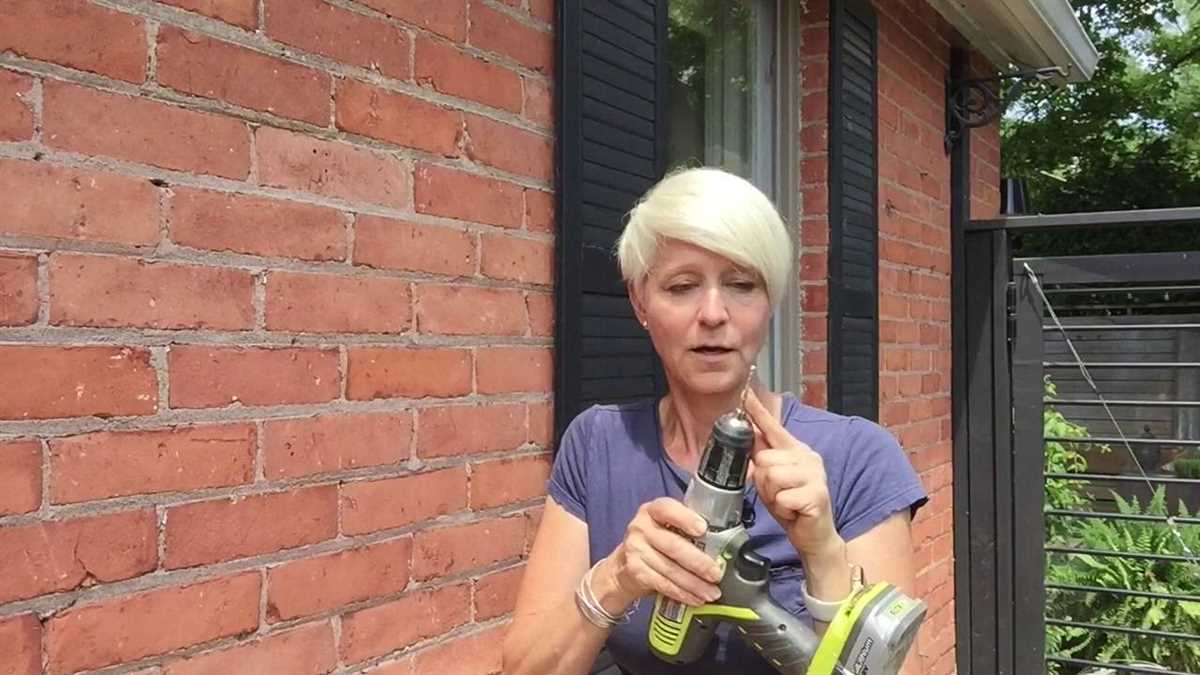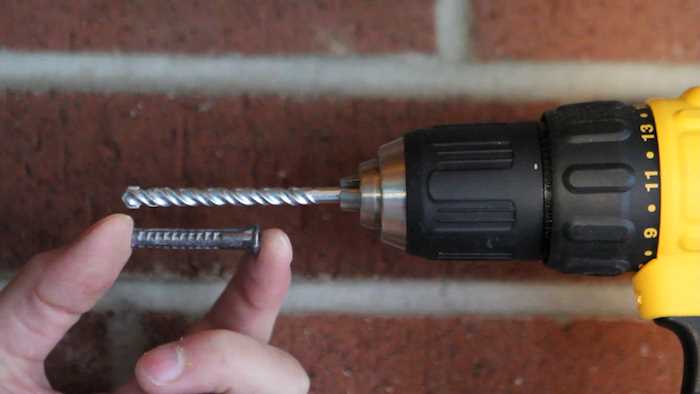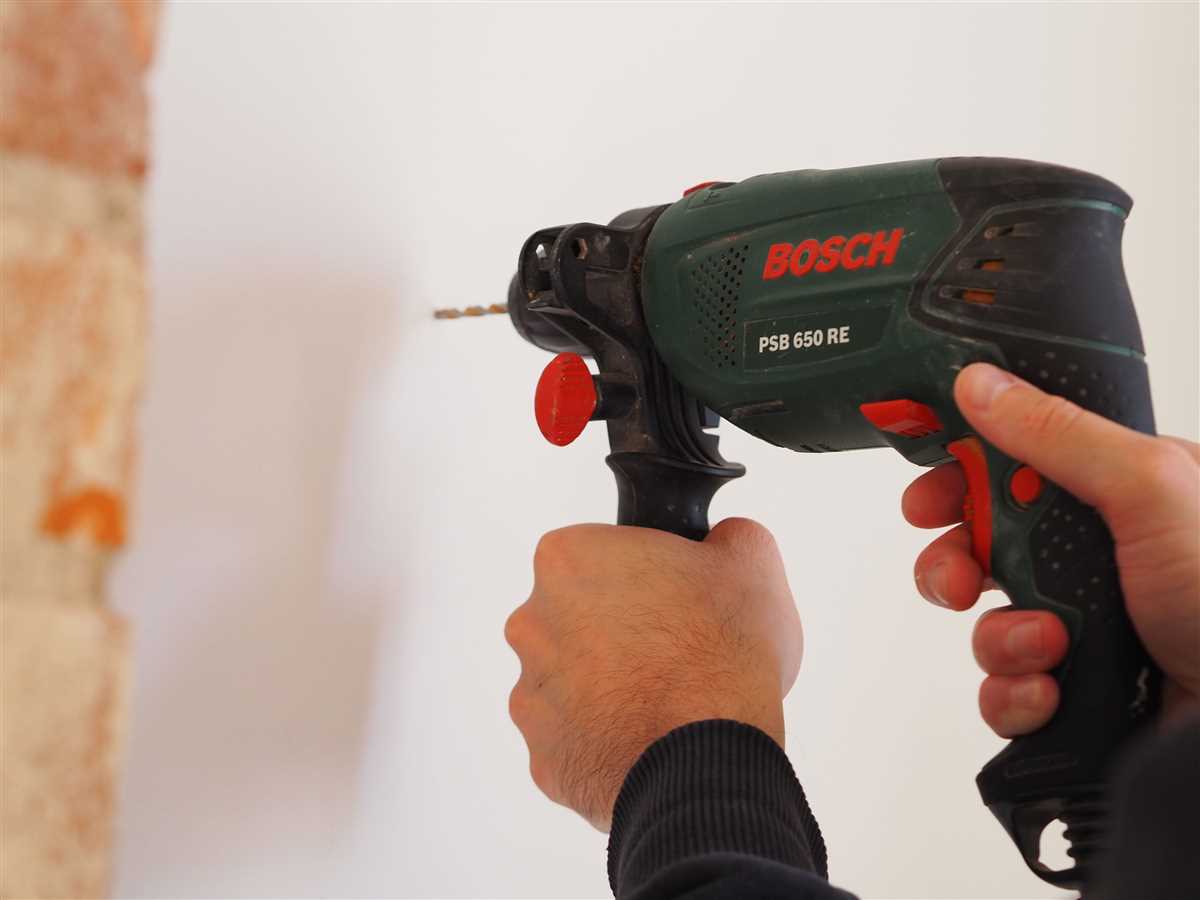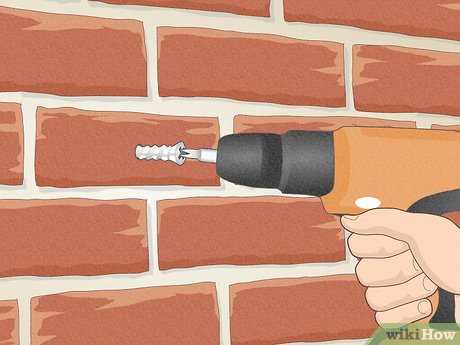Step-by-Step Guide: How to Drill into Masonry

When it comes to drilling into masonry, it can seem like a daunting task. However, with the right tools and techniques, you can easily drill into masonry and complete your project with confidence. Whether you’re hanging a shelf, installing a new light fixture, or adding a decorative element to your wall, drilling into masonry is a necessary skill to have.
Step 1: Prepare the area
Before you start drilling into masonry, it’s important to prepare the area. Clear away any debris or obstructions near the drilling location, and ensure that the surface is clean and dry. This will help provide a secure and stable drilling surface.
Tip: If you’re drilling into a wall, it’s a good idea to use a stud finder to locate the studs behind the masonry. This will help you avoid drilling into any electrical wiring or plumbing pipes.
Step 2: Choose the right drill bit
Choosing the right drill bit is crucial when drilling into masonry. Masonry bits are specifically designed to cut through brick, concrete, and other masonry materials. They are typically made of carbide or diamond grit, which is much harder than regular drill bits. Select a drill bit size that matches the diameter of the hole you need.
Tip: To ensure a clean and precise hole, mark the drilling location with a pencil or marker before you start drilling.
Step 3: Drill at the right speed
When drilling into masonry, it’s important to use the right drilling speed. Too fast, and you risk overheating the drill bit and damaging it. Too slow, and the drill bit may become stuck or take longer to penetrate the masonry. Start drilling at a slow speed, and gradually increase the speed as you go.
Tip: Apply steady pressure while drilling, but avoid pushing too hard. Let the drill bit do the work for you.
Step 4: Drill straight and steady
To achieve the best results when drilling into masonry, it’s important to keep the drill bit straight and steady. Start by positioning the drill bit perpendicular to the surface, and apply even pressure as you drill. Avoid wobbling or angling the drill, as this can lead to uneven holes or even breakage.
Tip: If you need to drill a deep hole, periodically withdraw the drill bit to clear away any dust or debris that may accumulate.
By following these step-by-step instructions, you can successfully drill into masonry and complete your project with ease. Remember to take your time, use the right tools, and practice proper safety precautions. Happy drilling!
Gather Your Tools and Materials
Before you begin drilling into masonry, make sure you have all the necessary tools and materials. Here is a list of items you will need:
- Drill: You will need a drill with a masonry drill bit. Make sure the drill has sufficient power to handle the job. A hammer drill is preferred for drilling into masonry.
- Masonry drill bit: Use a drill bit specifically designed for drilling into masonry, such as a carbide-tipped masonry bit. The size of the bit will depend on the size of the hole you need to drill.
- Protective equipment: Wear safety goggles to protect your eyes from flying debris. It is also a good idea to wear earplugs or earmuffs to protect your hearing, as drilling into masonry can be loud.
- Dust mask: Masonry drilling can produce a lot of dust, so wear a dust mask to avoid inhaling harmful particles.
- Measuring tape: Use a measuring tape to accurately measure and mark the desired location for the hole.
- Pencil or marker: Use a pencil or marker to mark the drilling location on the masonry surface.
- Level: A level will help ensure that the drilled hole is straight and level.
- Hammer: A hammer may be needed to gently tap the masonry drill bit into the surface before drilling.
- Vacuum or brush: Use a vacuum or brush to clean up dust and debris after drilling.
- Anchors or screws: Depending on the project, you may need anchors or screws to secure objects to the drilled holes.
Having all the necessary tools and materials ready before you start will help ensure a smooth drilling process and a successful outcome.
Choose the Right Drill Bit
When it comes to drilling into masonry, choosing the right drill bit is crucial. The type of drill bit you use will depend on the material you are drilling into and the size of the hole you need to make. Here are some factors to consider when selecting a drill bit:
- Material: Determine the material you will be drilling into. Common masonry materials include concrete, brick, and stone. Each material requires a specific drill bit designed to work best with it.
- Size: Consider the size of the hole you need to drill. Drill bits come in a variety of sizes, ranging from small diameters for precise holes to larger diameters for larger openings.
- Type of Drill Bit: There are several types of drill bits that are suitable for drilling into masonry. Some common types include masonry drill bits, carbide-tipped drill bits, and diamond-tipped drill bits. Each type has its own advantages and is designed for specific materials and applications.
Masonry Drill Bits: These drill bits are specially designed for drilling into masonry materials such as concrete, brick, and stone. They typically have a carbide or diamond tip for increased durability and enhanced drilling performance. Masonry drill bits are available in various sizes to accommodate different hole diameters.
Carbide-Tipped Drill Bits: These drill bits are made from high-speed steel with a carbide tip. They are very durable and are suitable for drilling into hard materials such as concrete and brick. Carbide-tipped drill bits are available in various sizes and are a good choice for general masonry drilling.
Diamond-Tipped Drill Bits: Diamond-tipped drill bits are the most durable and effective option for drilling into hard masonry materials like concrete and stone. The diamond tip on these bits can withstand high heat and provides excellent drilling performance. However, diamond-tipped drill bits are more expensive than other options.
Remember to always use the appropriate drill bit for the material you are drilling into to ensure clean and precise holes. Using the wrong drill bit can result in poor drilling performance, damage to the drill bit, and even potential injury.
| Drill Bit Type | Material Compatibility | Advantages |
|---|---|---|
| Masonry Drill Bits | Concrete, brick, stone | Good general-purpose drill bits for masonry |
| Carbide-Tipped Drill Bits | Concrete, brick, stone | High durability and suitable for hard materials |
| Diamond-Tipped Drill Bits | Concrete, stone | Most durable and effective option for hard materials |
By considering the material, size, and type of drill bit, you can ensure that you choose the right drill bit for your specific needs when drilling into masonry. This will help you achieve the best drilling results and prolong the life of your drill bits.
Prepare the Masonry Surface
Before you start drilling into masonry, it is important to properly prepare the surface to ensure a successful and safe drilling process.
Gather the necessary materials:
- Safety goggles or glasses
- Dust mask
- Gloves
- Tape measure
- Pencil or marker
- Clean cloth or brush
Assess the masonry surface:
Examine the area where you plan to drill to ensure it is suitable for drilling. Look for any cracks, loose sections, or uneven surfaces that could affect the stability of the drill and potentially cause damage.
Clear the drilling area:
Remove any obstructions, such as debris, dust, or loose objects, from the drilling area. This will help create a clean and safe work environment.
Measure and mark the drilling spot:
- Use a tape measure to determine the exact location where you want to drill.
- Mark the spot with a pencil or marker to ensure accuracy.
- If drilling multiple holes, use a level or straightedge to create a straight line or grid pattern for consistent placement.
Protect yourself:

Prior to drilling, put on safety goggles or glasses to protect your eyes from flying debris. It is also recommended to wear a dust mask to prevent inhaling any dust or particles.
Clean the surface:
Use a clean cloth or brush to remove any dust or loose particles from the drilling area. This will help ensure a clean and secure drilling surface.
Secure the masonry surface:
If the masonry surface is loose or unstable, it may be necessary to secure it before drilling. This can be done by using anchor bolts or other appropriate methods to reinforce the surface for added stability.
Check for any hidden utilities:
Before drilling, it is important to check for any hidden utilities, such as electrical wires or plumbing pipes, that may be behind the masonry surface. Use a stud finder or other appropriate tools to detect any potential hazards.
By properly preparing the masonry surface, you can ensure a safer and more successful drilling experience. Take the time to gather the necessary materials, assess the surface, clear the area, measure and mark the drilling spot, protect yourself, clean the surface, secure it if needed, and check for hidden utilities. These steps will help you create an ideal drilling environment and minimize the risk of damage or injury.
Secure the Masonry Surface
Before you begin drilling into masonry, it is important to properly secure the surface to prevent it from cracking or breaking during the drilling process. Here are the steps to secure the masonry surface:
- Remove any debris or loose material from the surface using a wire brush or broom. This will ensure a clean and even drilling surface.
- Inspect the masonry surface for any cracks or damage. If you notice any cracks, you may need to repair them before proceeding with drilling. Use a masonry patching compound to fill in any cracks and let it dry completely.
- Mark the drilling location on the masonry surface using a pencil or marker. This will help guide you during the drilling process and ensure accurate placement.
- If you are drilling into a tile or glass surface, place a piece of masking tape over the area where you will be drilling. This will help prevent the surface from cracking or chipping.
- If the masonry surface is vertical, use a clamp or vise to secure it in place. This will provide stability and prevent the surface from moving while you drill. Make sure the surface is level before securing it.
- For horizontal surfaces, such as a concrete floor, use clamps or weights to hold the surface in place. Again, make sure the surface is level before securing it.
- Consider using a drilling guide or template if you need to drill multiple holes with precise spacing. This will help ensure consistent and accurate hole placement.
By properly securing the masonry surface, you will reduce the risk of cracking or damaging the material during the drilling process. This will result in a clean and professional-looking finished product.
Mark Your Drilling Point
Before drilling into masonry, it is crucial to accurately mark your drilling point. This will help ensure that your hole is in the right location and at the correct depth.
To mark your drilling point, follow these steps:
- Start by checking the wall for any electrical or plumbing systems. Use a stud finder or consult a professional if needed.
- Measure and locate the position on the wall where you want to drill your hole. Use a tape measure and a level to ensure accuracy.
- Once you have determined the drilling point, use a pencil or marker to make a small mark on the wall.
- If you are drilling multiple holes, use a tape measure to ensure they are evenly spaced and marked.
Remember to avoid drilling too close to the edge of the masonry to prevent cracking or weakening the structure. Additionally, make sure to wear safety goggles and gloves throughout the drilling process.
Start Drilling into Masonry
Now that you have gathered all the necessary tools and materials, it’s time to start drilling into masonry. Follow these steps to ensure a successful drilling process:
Step 1: Mark the drilling spot
Begin by identifying the exact spot where you want to drill into the masonry. Use a pencil or chalk to mark this spot with a small dot. Make sure the mark is visible and accurate.
Step 2: Choose the right drill bit
Next, select the appropriate drill bit for your specific project. Masonry drill bits are specifically designed to drill into hard materials like concrete, brick, or stone. Ensure that the drill bit you choose is the correct size for the hole you intend to create.
Step 3: Wear safety gear
Before you start drilling, make sure you are wearing the right safety gear. Put on safety glasses to protect your eyes from any potential flying debris. It’s also a good idea to wear gloves to protect your hands.
Step 4: Set up your drill
If you’re using a corded drill, plug it into a nearby power outlet. If you’re using a cordless drill, ensure that the battery is fully charged. Attach the chosen masonry drill bit securely into the chuck of the drill.
Step 5: Drill slowly and steadily
Position the drill bit directly on the marked spot on the masonry. Apply gentle pressure and start the drill at a low speed. Slowly increase the speed as you continue drilling. Maintain a steady and controlled motion throughout the drilling process.
Step 6: Clear debris periodically

As you drill, debris may accumulate in the hole. Take breaks from drilling to clear away any loose material using a vacuum or a brush. This will help prevent the drill bit from getting clogged and ensure a clean hole.
Step 7: Drill to the desired depth
Continue drilling until you reach the desired depth. If you’re drilling into a wall to hang something, make sure to drill to a depth that will provide enough support for your fixture. Check the depth periodically using a ruler or depth gauge.
Step 8: Remove the drill bit and clean up
Once you have reached the desired depth, release the trigger on the drill and carefully pull the drill bit out of the hole. Use a brush or vacuum to clean up any remaining debris. You are now ready to proceed with your project!
Remember to always exercise caution when drilling into masonry. Follow these steps carefully to ensure your safety and the success of your project. Good luck!
Flush Out Dust

After drilling into the masonry, you will need to flush out the dust from the hole to ensure proper installation and maximum holding power. Here’s how:
Materials you’ll need:
- A bucket of water
- A soft-bristle brush
- A sponge
- A towel
Steps:
- Fill the bucket with water.
- Dip the soft-bristle brush into the water.
- Gently brush the inside of the drilled hole to remove any loose debris and dust.
- Use the sponge soaked in water to wipe down the walls of the hole, ensuring it is clean and free of dust.
- Allow the hole to air dry for a few minutes.
- Use the towel to pat dry the hole if necessary.
Flushing out the dust is a critical step to ensure a tight fit for the anchor and to maintain the structural integrity of the masonry. Taking the time to remove any debris will help to create a strong and secure mount for your fixture or anchor.
Finish and Clean Up
After you have finished drilling into the masonry, there are a few steps you can follow to ensure a clean and tidy work area:
1. Remove any debris
Use a brush or vacuum cleaner to remove any loose debris or dust from the drilled holes and surrounding area. This will help prevent any blockages or obstructions when installing screws or anchors.
2. Check for any damage

Inspect the drilled holes to ensure that they are clean and free from any cracks or damage. If you notice any issues, you may need to re-drill the holes or consult a professional to assess the damage.
3. Clean up the drilling tools
Thoroughly clean the drilling tools, such as the drill bit or hammer drill, to remove any built-up debris or dust. This will help maintain the performance and longevity of your tools.
4. Store the tools properly
After cleaning, store the drilling tools in a dry and secure place to prevent any rust or damage. Consider using a case or toolbox to keep them organized and protected.
5. Dispose of waste materials responsibly
Dispose of any waste materials, such as broken bits of masonry or dust, in accordance with local regulations. Do not simply discard them in regular household waste bins.
6. Clean the work area
Finally, clean the work area to remove any additional dust or residue. Use a broom or mop to sweep or wash the floor, and wipe down any surfaces with a damp cloth.
Following these steps will help you complete the drilling process and leave your work area clean and tidy.
FAQ:
What is masonry?
Masonry refers to a construction technique using materials like bricks, stones, or concrete blocks, usually held together by mortar.
Why would I need to drill into masonry?
You may need to drill into masonry for various reasons, such as installing shelves, hanging artwork, or mounting fixtures like curtain rods.
What tools do I need to drill into masonry?
To drill into masonry, you will need a hammer drill, masonry drill bits, safety goggles, a dust mask, a tape measure, and a pencil.
Can I use a regular drill for drilling into masonry?
No, a regular drill will not be effective for drilling into masonry. You need a hammer drill specifically designed for this purpose.
How do I choose the right masonry drill bit?
When choosing a masonry drill bit, consider the material you will be drilling into and the size of the hole you need. Use a carbide-tipped drill bit for concrete and a diamond-tipped drill bit for harder materials like stone.
What safety precautions should I take when drilling into masonry?
When drilling into masonry, always wear safety goggles to protect your eyes from debris. It’s also advisable to wear a dust mask to avoid inhaling any harmful particles.
Video:











